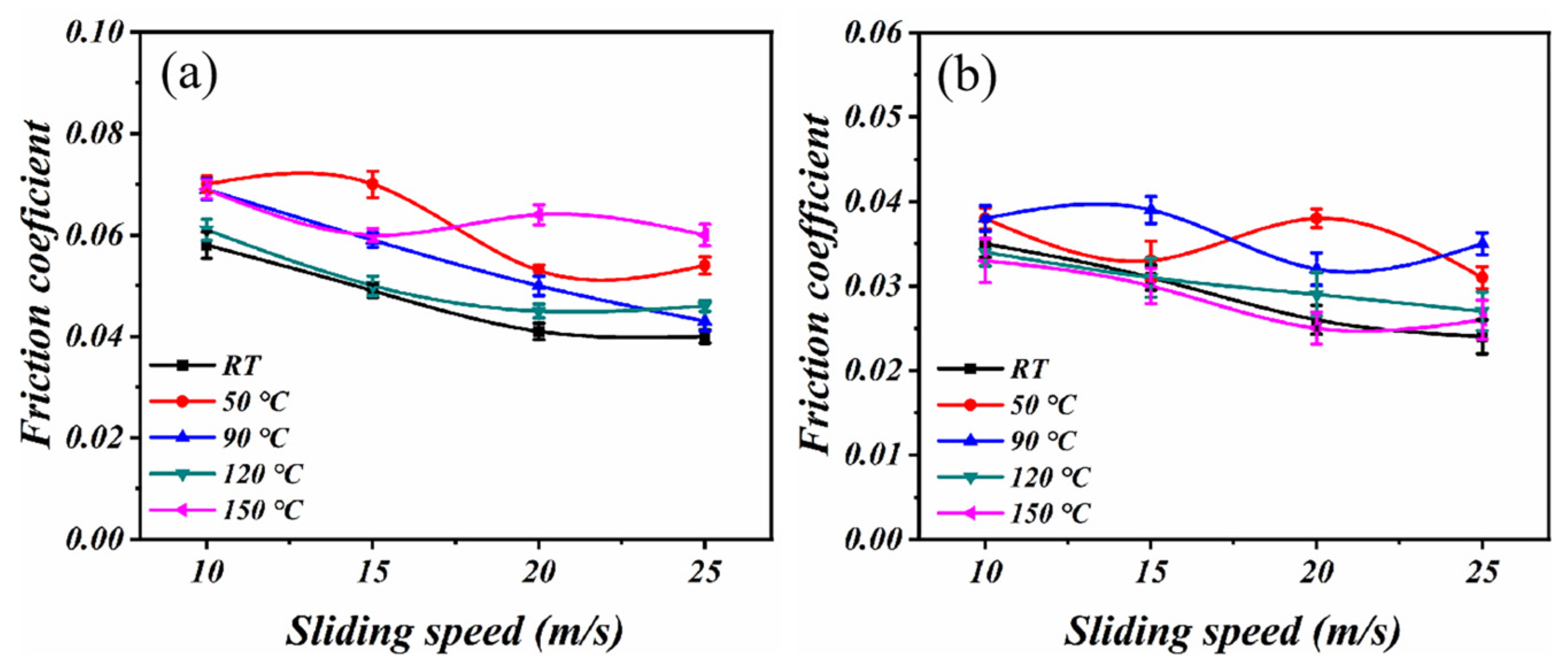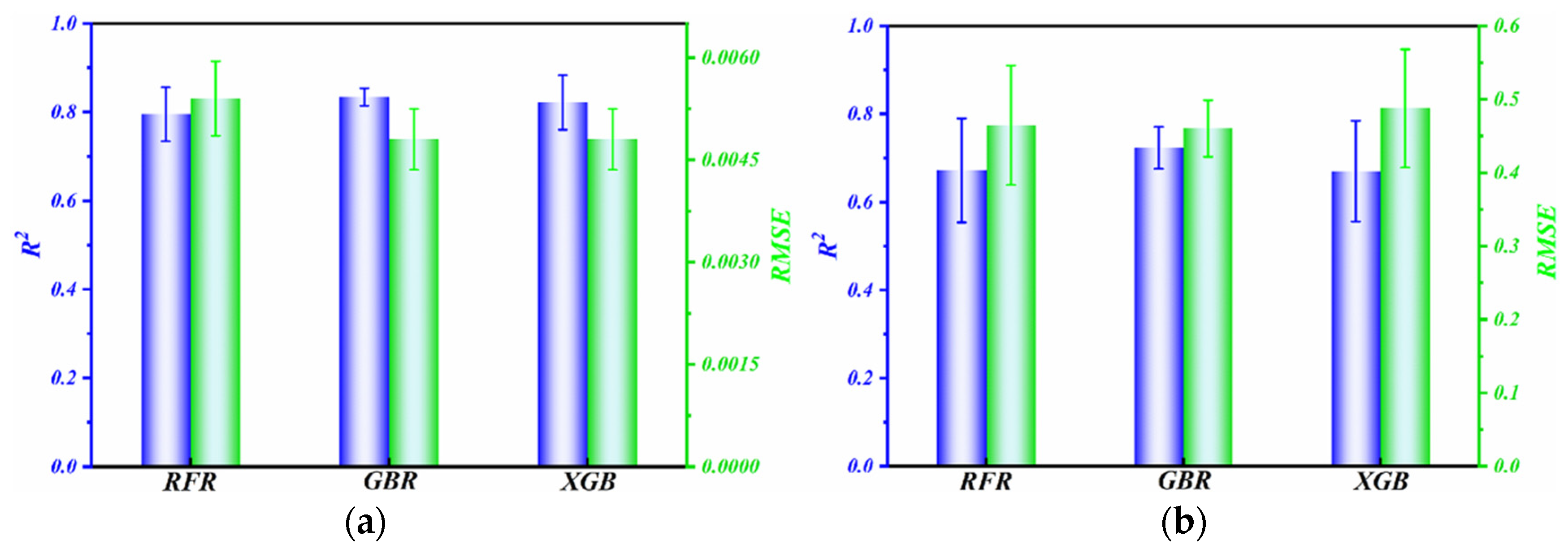Prediction of the Tribological Properties of Polytetrafluoroethylene Composites Based on Experiments and Machine Learning
Abstract
1. Introduction
2. Materials and Methods
2.1. Materials and Preparation
2.2. Tribological Tests
2.3. Characterizations
3. Results
4. Conclusions
- The transition from boundary lubrication to elastohydrodynamic lubrication and the formation of a continuous lubricating film play crucial roles in reducing the friction coefficient and wear rate.
- The GBR model exhibited better predictive capabilities for both the friction coefficient and wear rate compared to the RFR and XGBoost models.
- The correlation coefficients between the temperature, load, and speed with the friction coefficient and wear rate were calculated, revealing that the load and speed are the most significant factors influencing the tribological properties of PTFE composites.
Supplementary Materials
Author Contributions
Funding
Institutional Review Board Statement
Data Availability Statement
Conflicts of Interest
References
- Johansson, P.; Marklund, P.; Björling, M.; Shi, Y. Mechanisms behind the environmental sensitivity of carbon fiber reinforced polytetrafluoroethylene (PTFE). Friction 2023, 1–19. [Google Scholar] [CrossRef]
- Li, Z.; Qi, X.; Liu, C.; Fan, B.; Yang, X. Particle size effect of PTFE on friction and wear properties of glass fiber reinforced epoxy resin composites. Wear 2023, 532, 205104. [Google Scholar] [CrossRef]
- Chai, J.; Wang, G.; Zhang, A.; Li, X.; Xu, Z.; Zhao, J.; Zhao, G. Robust polytetrafluoroethylene (PTFE) nanofibrous membrane achieved by shear-induced in-situ fibrillation for fast oil/water separation and solid removal in harsh solvents. Chem. Eng. J. 2023, 461, 141971. [Google Scholar] [CrossRef]
- Li, S.; Duan, C.; Li, X.; Shao, M.; Qu, C.; Zhang, D.; Wang, Q.; Wang, T.; Zhang, X. The effect of different layered materials on the tribological properties of PTFE composites. Friction 2020, 8, 542–552. [Google Scholar] [CrossRef]
- Liu, S.; Wang, Y.; Li, N.; Hu, Z.; Chen, S. PTFE-reinforced pore-filling proton exchange membranes with sulfonated poly(ether ether ketone)s and poly(aryl ether sulfone)s. J. Membr. Sci. 2024, 694, 122431. [Google Scholar] [CrossRef]
- Ren, W.; Chen, G. Experimental study on the wear mechanism of the contact line in rigid pantograph-catenary systems. Tribol. Int. 2023, 187, 108739. [Google Scholar] [CrossRef]
- Liang, C.; Gong, Y.; Zhou, L.; Qi, Y.; Zhang, H.; Zhao, J. Tool Wear Mechanism and Grinding Performance for Different Cooling-Lubrication Modes in Grinding of Nickel-Based Superalloys. Materials 2023, 16, 3545. [Google Scholar] [CrossRef]
- Cai, P.; Wang, T.; Wang, Q. Formulation Optimization of Friction Material with Golden Section Approach. Tribol. Trans. 2015, 59, 28–32. [Google Scholar] [CrossRef]
- Li, S.; Shao, M.; Duan, C.; Yan, Y.; Wang, Q.; Wang, T.; Zhang, X. Tribological behavior prediction of friction materials for ultrasonic motors using Monte Carlo-based artificial neural network. J. Appl. Polym. Sci. 2018, 136, 47157. [Google Scholar] [CrossRef]
- Satapathy, B.K.; Bijwe, J. Composite friction materials based on organic fibres: Sensitivity of friction and wear to operating variables. Compos. Part A Appl. Sci. Manuf. 2006, 37, 1557–1567. [Google Scholar] [CrossRef]
- Rosenkranz, A.; Marian, M.; Profito, F.J.; Aragon, N.; Shah, R. The use of artificial intelligence in tribology—A perspective. Lubricants 2020, 9, 2. [Google Scholar] [CrossRef]
- Marian, M.; Mursak, J.; Bartz, M.; Profito, F.J.; Rosenkranz, A.; Wartzack, S. Predicting EHL film thickness parameters by machine learning approaches. Friction 2023, 11, 992–1013. [Google Scholar] [CrossRef]
- Cheng, D.; Sha, W.; Han, Q.; Tang, S.; Zhong, J.; Du, J.; Tian, J.; Cao, Y.-C. ACGNet: An interpretable attention crystal graph neural network for accurate oxidation potential prediction. Electrochim. Acta 2024, 473, 143459. [Google Scholar] [CrossRef]
- Liang, C.; Rouzhahong, Y.; Ye, C.; Li, C.; Wang, B.; Li, H. Material symmetry recognition and property prediction accomplished by crystal capsule representation. Nat. Commun. 2023, 14, 5198. [Google Scholar] [CrossRef]
- Zhao, F.; Tang, L.; Jiang, H.; Mao, Y.; Song, W.; Chen, H. Prediction of heavy metals adsorption by hydrochars and identification of critical factors using machine learning algorithms. Bioresour. Technol. 2023, 383, 129223. [Google Scholar] [CrossRef]
- Ibrahim, M.S.; Dong, W.; Yang, Q. Machine learning driven smart electric power systems: Current trends and new perspectives. Appl. Energy 2020, 272, 115237. [Google Scholar] [CrossRef]
- Li, L.; Rong, S.; Wang, R.; Yu, S. Recent advances in artificial intelligence and machine learning for nonlinear relationship analysis and process control in drinking water treatment: A review. Chem. Eng. J. 2021, 405, 126673. [Google Scholar] [CrossRef]
- Lin, Y.; Ma, J.; Wang, Q.; Sun, D.-W. Applications of machine learning techniques for enhancing nondestructive food quality and safety detection. Crit. Rev. Food Sci. Nutr. 2023, 63, 1649–1669. [Google Scholar] [CrossRef]
- Mondal, P.P.; Galodha, A.; Verma, V.K.; Singh, V.; Show, P.L.; Awasthi, M.K.; Lall, B.; Anees, S.; Pollmann, K.; Jain, R. Review on machine learning-based bioprocess optimization, monitoring, and control systems. Bioresour. Technol. 2023, 370, 128523. [Google Scholar] [CrossRef]
- Wang, G.; Ruan, Y.; Wang, H.; Zhao, G.; Cao, X.; Li, X.; Ding, Q. Tribological performance study and prediction of copper coated by MoS2 based on GBRT method. Tribol. Int. 2023, 179, 108149. [Google Scholar] [CrossRef]
- Cheng, G.; Xiang, C.; Guo, F.; Wen, X.; Jia, X. Prediction of the tribological properties of a polymer surface in a wide temperature range using machine learning algorithm based on friction noise. Tribol. Int. 2023, 180, 108213. [Google Scholar] [CrossRef]
- Li, S.; Zhang, N.; Yang, Z.; Li, X.; Zhao, G.; Wang, T.; Wang, Q.; Zhang, X. Tailoring friction interface with surface texture for high-performance ultrasonic motor friction materials. Tribol. Int. 2019, 136, 412–420. [Google Scholar] [CrossRef]
- Wang, Q.; Wang, X.; Zhang, X.; Li, S.; Wang, T. Tribological properties study and prediction of PTFE composites based on experiments and machine learning. Tribol. Int. 2023, 188, 108815. [Google Scholar] [CrossRef]
- Legates, D.R.; McCabe, G.J., Jr. Evaluating the use of “goodness-of-fit” measures in hydrologic and hydroclimatic model validation. Water Resour. Res. 1999, 35, 233–241. [Google Scholar] [CrossRef]
- Dao, D.V.; Ly, H.-B.; Trinh, S.H.; Le, T.-T.; Pham, B.T. Artificial intelligence approaches for prediction of compressive strength of geopolymer concrete. Materials 2019, 12, 983. [Google Scholar] [CrossRef]
- Huang, Z.; Turner, B.J.; Dury, S.J.; Wallis, I.R.; Foley, W.J. Estimating foliage nitrogen concentration from HYMAP data using continuum removal analysis. Remote Sens. Environ. 2004, 93, 18–29. [Google Scholar] [CrossRef]
- Chen, Q.; Morita, T.; Sawae, Y.; Fukuda, K.; Sugimura, J. Effects of trace moisture content on tribofilm formation, friction and wear of CF-filled PTFE in hydrogen. Tribol. Int. 2023, 188, 108905. [Google Scholar] [CrossRef]










| PTFE | PI | Mica |
|---|---|---|
| 65% | 5% | 30% |
| Operating Conditions | Parameters |
|---|---|
| Speed (m/s) | 10, 15, 20, 25 |
| Temperature (°C) | Room temperature (RT), 50, 90, 120, 150 |
| Load (MPa) | 0.05, 0.10 |
Disclaimer/Publisher’s Note: The statements, opinions and data contained in all publications are solely those of the individual author(s) and contributor(s) and not of MDPI and/or the editor(s). MDPI and/or the editor(s) disclaim responsibility for any injury to people or property resulting from any ideas, methods, instructions or products referred to in the content. |
© 2024 by the authors. Licensee MDPI, Basel, Switzerland. This article is an open access article distributed under the terms and conditions of the Creative Commons Attribution (CC BY) license (https://creativecommons.org/licenses/by/4.0/).
Share and Cite
Yan, Y.; Du, J.; Ren, S.; Shao, M. Prediction of the Tribological Properties of Polytetrafluoroethylene Composites Based on Experiments and Machine Learning. Polymers 2024, 16, 356. https://doi.org/10.3390/polym16030356
Yan Y, Du J, Ren S, Shao M. Prediction of the Tribological Properties of Polytetrafluoroethylene Composites Based on Experiments and Machine Learning. Polymers. 2024; 16(3):356. https://doi.org/10.3390/polym16030356
Chicago/Turabian StyleYan, Yingnan, Jiliang Du, Shiwei Ren, and Mingchao Shao. 2024. "Prediction of the Tribological Properties of Polytetrafluoroethylene Composites Based on Experiments and Machine Learning" Polymers 16, no. 3: 356. https://doi.org/10.3390/polym16030356
APA StyleYan, Y., Du, J., Ren, S., & Shao, M. (2024). Prediction of the Tribological Properties of Polytetrafluoroethylene Composites Based on Experiments and Machine Learning. Polymers, 16(3), 356. https://doi.org/10.3390/polym16030356







